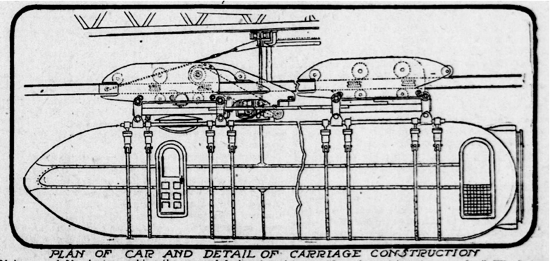Zipping from San Francisco to Oakland in 5 Minutes
An inventor’s plans for traveling inside a giant bullet would have made a trip across the Bay a fast one
/https://tf-cmsv2-smithsonianmag-media.s3.amazonaws.com/filer/201111141150131910-April-17-San-Francisco-Call-470x251.jpg)
Last week I had two friends from the Bay Area over to my apartment in Los Angeles. They recently moved to San Francisco from Oakland and I asked how they liked their new digs. ”We love it. But I wish there was a way to get between Oakland and San Francisco easier.”
They explained that the BART trains stop running at around 12:30 at night, which makes going to see friends for drinks and such rather impractical if you can’t find your way home. But, if inventor Fletcher E. Felts had gotten his way, not only would my friends be able to hop from San Francisco to Oakland in just five minutes, they would’ve been able to zip down to visit me in Los Angeles in just four hours, without having to deal with the fuss of flying or driving a car.
The April 17, 1910 San Francisco Call ran an article titled, ”From Call Building to Oakland City Hall in 5 Minutes.” The Call Building in San Francisco is now known as Central Tower. Felts lived in Los Angeles but had once lived in San Francisco and imagined a system of suspended auto motor railways that would “revolutionize railroading the world over.”
3 p. m. — “All aboard for Oak-land!”
3:05p. m. — “Oak-land, Oak-land. All off!”
That’s what you’ll be hearing some day when the “Suspended Auto Motor Railway” is in operation.
It will be a case of “on again, off again,” for you will have scarcely made yourself comfortable in your seat when, b-r-r, buzz-z-z, buz-z-z, and you are flying across the bay in midair with the speed of a gun projectile, and almost before you can say “Jack Robinson” you have landed in the Athens of the Pacific.
Now, that’s rather a startling statement, isn’t it? But Fletcher E. Felts, who has looked into the future, says we are going to have such a railway.
“Oh, pshaw!” you say contemptuously, it’s only a dream.” But, you know, some dreams come true. Who ever thought men would be able to sail through under the waters of the ocean in safety? They have done so in submarines. Or, whoever thought that men would ever be able to sail through the air at dizzy heights with ease? They are doing so in flying machines. Well, now that these supposed to be impossible feats have been accomplished, why be skeptical about anything?
The San Francisco Call included Felts’ design for the railway cars:

"Plan of car and detail of carriage construction."
Felts explained the design of his “bullet car” and the aerial railway:
“The car, which is bullet shaped, lays in surcingles which terminate in springs and plungers. The operator sits in a conning tower in the top of the car. Levers run back over his head to the engine. In place of the trucks beneath the car there are steel carriages above. These steel carriages will encircle the eyebeam tracks and all the wheels and rollers will be slotted at their tops, wide enough only to permit the passing of the drop arms. Should the wheels and rollers be removed by any cause, the carriages would clutch the track, preventing the car from falling, or, if any portion of the track should be taken away and the cars running at full speed the front carriage only would leave the track, causing the rear carriage to clutch the track before travelling the length of the car. This would prevent the car from plunging into space.
Felts clearly had a bigger vision for his railway system than just Oakland to San Francisco, explaining that a trip from Los Angeles to San Francisco could take just under four hours:
“My suspended auto motor railway, at the rate of 100 miles per hour, would make the same distance of 471 miles in 5 hours, including five stops of five minutes each,” said Felts. “This distance between San Francisco and Los Angeles could be shortened to 400 miles with the suspended auto motor railway, and the speed easily increased to 150 miles per hour, making the time between San Francisco and Los Angeles 3 hours and 39 minutes. The stops would be San Jose, Paso Robles, San Luis Obispo, Santa Barbara and Los Angeles.
High speed rail has been a hot button political topic in California, with the California High-Speed Rail Authority claiming that such a system today could link Los Angeles and San Francisco with trains taking just 2 hours and 40 minutes. California voters approved $9.95 billion in funding for high speed rail in 2008 but the project has many hurdles before it becomes a reality.
/https://tf-cmsv2-smithsonianmag-media.s3.amazonaws.com/accounts/headshot/matt-novak-240.jpg)
/https://tf-cmsv2-smithsonianmag-media.s3.amazonaws.com/accounts/headshot/matt-novak-240.jpg)